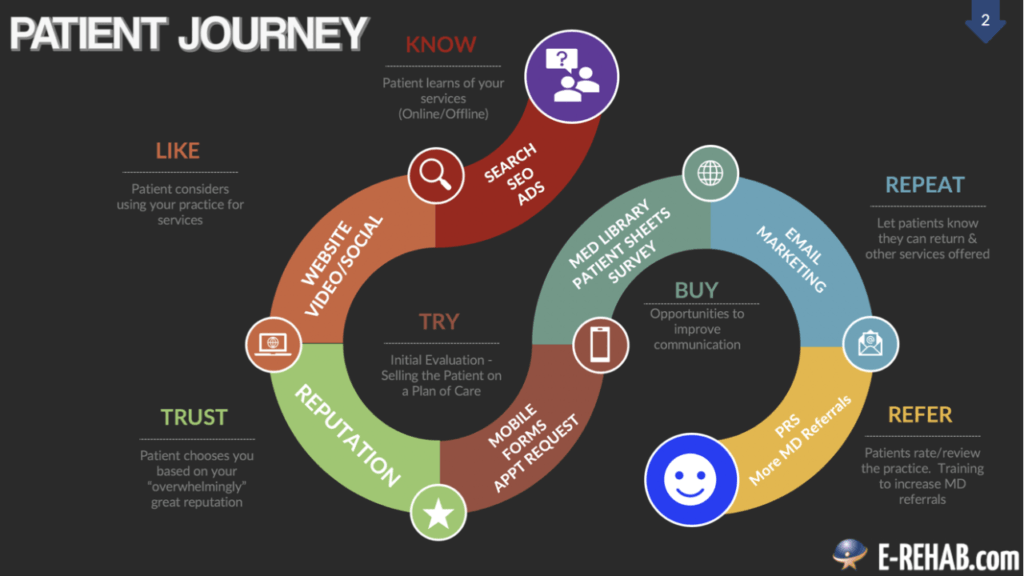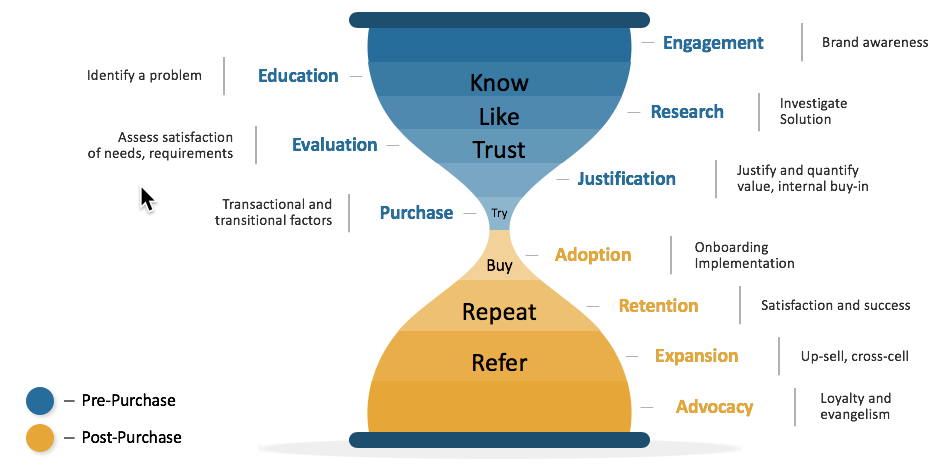When it comes to laying out an effective physical therapy marketing strategy, it helps to have a conceptual structure to serve as the backbone for decision making. Figuring out how to formulate this structure can be challenging, but one smart guiding principle is to follow the shape of an hourglass to understand various thoughts patients go through when choosing a PT private practice.
For a long while, business owners and marketers were told to focus on the idea of the marketing funnel. To make matters more confusing, enterprise companies, marketing experts, and gurus have come up with different types of funnels. Generally, a funnel is a concept that you conceptually describes the large target group of people that might be interested in your services (the top or largest end of the funnel), and then describes the thoughts, steps, or processes prospective patients go through…with people walking in the door, and doing business with you, being down toward the bottom of the funnel (the small end) where they become customers, clients, or patients. Many funnels include retention, repeat business, and referrals also down at the small end of the funnel. The problem with this concept is that this concept doesn’t do enough to emphasize the importance of great customer service and the future ramifications as a result of delivering great care. As John says,
“Of course, the funnel concept won’t ever go away, but about ten years ago I defined what I think is still a much better approach – I call it the Marketing Hourglass. It borrows from the funnel shape but turns it on its head after the purchase to help intentionally account for the idea of creating a remarkable customer experience.”
The marketing funnel would usually consist of about three steps on the front end of the process—such as awareness, consideration, and purchase—but did not account for what happens to the patient after their initial evaluation at your clinic. On account of its symmetric shape, the marketing hourglass approach gives equal attention to both building trust on the front end and ensure an optimal patient experience from the moment they walk through your doors and all that follows.
The 7 steps of the hourglass to shape your physical therapy marketing ideas around
Before constructing your marketing hourglass, you need to take stock of how your physical therapy practice comes into contact with prospective patients through various touchpoints, and then try to map the journey that would lead them to call your clinic for their first visit. Once you have a good idea of these points, you can begin crafting your marketing plan by following these 7 steps of the marketing hourglass approach:
- 1. Know: try to understand how most of your prospective patients will first hear about your practice, whether that be through an online ad, referral, or something else.
- 2. Like: if someone learns of your practice they often will want to know more about you before they call to schedule or request an appointment online. This is where a great website with authoritative and up-to-date content comes in.
- 3. Trust: before a patient chooses your practice, they will also want to see that they can trust you; the best way to do this is with reviews, success stories, and testimonials. Video is something that most practices are still NOT leveraging to build trust. It’s something to consider.
- 4. Try: we define trying physical therapy as the communication during appointment setup and the initial evaluation. There are a number of opportunities to optimize these experiences. From answering the phone, what you say, being on time, evaluating the patient and communicating properly. This step is where you sell the patient on your plan of care.
- 5. Buy: the first step on the opposite side of the hourglass, this is the actual treatment phase of a patient’s experience; work to ensure a positive patient experience that exceeds their expectations; from proper goal setting, reinforcing progress, a good home-exercise program, and regularly checking in with the patient to make sure the plan of care is progressing as expected…these are all areas you can work on at this stage.
- 6. Repeat: after ensuring that the patient had a positive first experience at your practice, shift the focus to follow up. After they have completed their plan of care, how are they doing on their own. Follow-up letters, phone calls, and regular offers to come back can help here.
- 7. Refer: you know who your patient ambassadors are… you know, the ones that love you, the ones that you made a significant change in their life. When these patient views your practice in this positive light, you want to make it as easy as possible for them to refer you to others by creating tools they can access through your website or elsewhere.
Another Way to Look at Your Physical Therapy Marketing – The Patient Journey

The marketing hourglass is a great way to visualize the process that patients go through. Another way to visually describe this is the patient journey. While there are dozens of touch points, one way to look at it is by asking yourself, “What online marketing technologies can I use to connect with prospects and patients through the journey.” This graphic we created might help you visualize some of the opportunities. We tied it into the marketing hourglass as well.
What are you doing to optimize your marketing?
Take a look at the above and see if you have any real blind spots. What can 2-3 things can you affordably and effectively do to get people into the hourglass and optimize their experience as they go through it.
If you’re looking for additional assistance or other physical therapy marketing ideas, we can help. Give us a call to find out what we can do for your private physical therapy practice.


Leave a Reply
You must be logged in to post a comment.